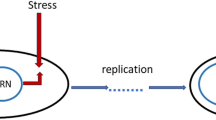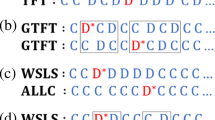Abstract
In a series of papers, Forber and Smead (J Philos 111(3):151–166, 2014, Biol Philos 30(3):405–421, 2015) and Smead and Forber (Evolution 67(3):698–707, 2013) make a valuable contribution to the study of cooperation in finite populations by analyzing an understudied model: the prisoner’s delight. It always pays to cooperate in the one-shot prisoner’s delight, so this model presents a best-case scenario for the evolution of cooperation. Yet, what Forber and Smead find is highly counterintuitive. In finite populations playing the prisoner’s delight, increasing the benefit of cooperation causes selection to favor defection. Here, I extend their model by considering the effects of non-linear payoffs. In particular, I show that interesting subtleties arise when payoffs are synergistic. Indeed, analysis reveals that increasing the benefit of cooperation does not always favor the spread of defection if payoffs are synergistic. I conclude by drawing some general considerations about robustness analysis in evolutionary models.

Similar content being viewed by others
Notes
Strictly speaking, the range of α(xC) and β(xC) is here the set of natural numbers less than N. So the notions of steepness, inflection point, and other terms that apply to continuous functions are not defined for these functions. Here, I use these terms as a convenient short-hand for what would be the case in the limit of α(xC) and β(xC) as N goes to infinity, but my results do not depend on this. Similar functions have been studied in non-cooperative settings by Archetti and Scheuring (2011).
References
Allen B, Nowak MA, Wilson EO (2013) Limitations of inclusive fitness. Proc Natl Acad Sci 110(50):20135–20139
Archetti M, Scheuring I (2011) Coexistence of cooperation and defection in public goods games. Evolution 65(4):1140–1148
Bonner JT (2009) The social amoebae: the biology of cellular slime molds. Princeton University Press, Princeton
Cavalli-Sforza LL, Feldman MW (1978) Darwinian selection and “altruism”. Theor Popul Biol 14(2):268–280
Forber P, Smead R (2014) An evolutionary paradox for prosocial behavior. J Philos 111(3):151–166
Forber P, Smead R (2015) Evolution and the classification of social behavior. Biol Philos 30(3):405–421
Hamilton WD (1971) Selection of selfish and altruistic behavior in some extreme models. In: Man and beast: comparative social behavior, pp 57–91
Hardin G (1968) The tragedy of the commons. Science 162:1243–1248
Levins R (1966) The strategy of model building in population biology. Am Sci 54(4):421–431
Maynard-Smith J, Price GR (1973) The logic of animal conflict. Nature 246:15–18
Milinski M, Semmann D, Krambeck H-J, Marotzke J (2006) Stabilizing the Earth’s climate is not a losing game: supporting evidence from public goods experiments. Proc Natl Acad Sci USA 103(11):3994–3998
Miller MB, Bassler BL (2001) Quorum sensing in bacteria. Annu Rev Microbiol 55(1):165–199
Nowak MA, Sasaki A, Taylor C, Fudenberg D (2004) Emergence of cooperation and evolutionary stability in finite populations. Nature 428(6983):646
Orzack SH, Sober E (1993) A critical assessment of Levins’s the strategy of model building in population biology (1966). Q Rev Biol 68:533–546
Packer C, Scheel D, Pusey AE (1990) Why lions form groups: food is not enough. Am Nat 136(1):1–19
Smead R, Forber P (2013) The evolutionary dynamics of spite in finite populations. Evolution 67(3):698–707
Taylor C, Fudenberg D, Sasaki A, Nowak MA (2004) Evolutionary game dynamics in finite populations. Bull Math Biol 66(6):1621–1644
Tomasello M, Melis AP, Tennie C, Wyman E, Herrmann E, Gilby IC, Hawkes K, Sterelny K, Wyman E, Tomasello M, Melis A (2012) Two key steps in the evolution of human cooperation: the interdependence hypothesis. Curr Anthropol 53(6):673–692
van Veelen M (2009) Group selection, kin selection, altruism and cooperation: when inclusive fitness is right and when it can be wrong. J Theor Biol 259(3):589–600
Weisberg M (2006) Robustness analysis. Philos Sci 73(5):730–742
Weisberg M, Reisman K (2008) The robust Volterra principle. Philos Sci 75(1):106–131
Yip EC, Powers KS, Avilés L (2008) Cooperative capture of large prey solves scaling challenge faced by spider societies. Proc Natl Acad Sci 105(33):11818–11822
Acknowledgements
I thank Alex Rosenberg, Rory Smead, Hannah Read, and especially two anonymous referees for helpful feedback on previous drafts of this paper.
Author information
Authors and Affiliations
Corresponding author
Additional information
Publisher's Note
Springer Nature remains neutral with regard to jurisdictional claims in published maps and institutional affiliations.
Rights and permissions
About this article
Cite this article
Ventura, R. The evolution of cooperation in finite populations with synergistic payoffs. Biol Philos 34, 43 (2019). https://doi.org/10.1007/s10539-019-9695-x
Received:
Accepted:
Published:
DOI: https://doi.org/10.1007/s10539-019-9695-x




